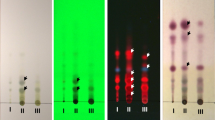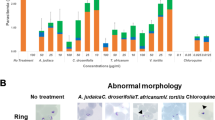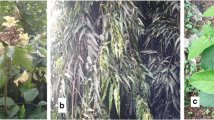Abstract
Severe malaria is one of the leading causes of mortality among children and pregnant woman globally. Resistance development against the frontline antimalarial drugs has created an alarming situation, which requires intensive drug discovery to develop effective, affordable, and accessible antimalarial agents possessing novel modes of action. As a part of our drug discovery program for antimalarial agents from plants, phytol a very commonly occurring diterpene alcohol in the plant was investigated for its antimalarial potential. In vitro antiplasmodial activity against the chloroquine-sensitive Plasmodium falciparum NF54 by measuring the parasite specific lactate dehydrogenase (pfLDH), showed moderate activity (IC50 211.5 ± 0.93 µM). Further, phytol was chemically converted into thirteen derivatives, which were evaluated for their antiplasmodial potential. All the derivatives were moderate active, but among all the derivatives palmitoyl (PhY-3; IC50 12.13 ± 0.31 µM) has found most active without any cytotoxic effect on macrophage cells. PhY-3 was further validated in an in vivo system for its efficacy and safety profile in mice. Oral administration of PhY-3 showed significant reduction of parasitemia and increased mean survival time. It also attributed significant increase in blood glucose and hemoglobin level, when compared with vehicle-treated P. berghei infected mice without any toxic effect on normal mice at a higher dose. These findings confirm suitability of the phytol derivatives as new chemical entities for further investigation towards the management of malaria.



Similar content being viewed by others
References
Aguiar AC, Pereira DB, Amaral NS, De Marco L, Krettli AU (2014) Plasmodium vivax and Plasmodium falciparum ex vivo susceptibility to antimalarials and gene characterization in Rondonia, West Amazon, Brazil. Malar J 13:73
Ariey F, Witkowski B, Amaratunga C, Beghain J, Langlois AC, Khim N, Kim S, Duru V, Bouchier C et al. (2014) A molecular marker of artemisinin-resistant Plasmodium falciparum malaria. Nature 505:50–55
Balasubramaniam P, Malathi A (1992) Comparative study of hemoglobin estimated by Drabkin′s and Sahli′s methods. J Postgrad Med 38:8–9
Boeuf PS, Loizon S, Awandare GA, Tetteh JK, Addae MM, Adjei GO, Goka B, Kurtzhals JA, Puijalon O, Hviid L, Akanmori BD, Behr C (2012) Insights into deregulated TNF-α and IL-10 production in malaria: implications for understanding severe malarial anaemia. Malar J 11:253
Butler MS, Buss AD (2006) Natural products—the future scaffolds for novel antibiotics? Biochem Pharmacol 71:919–929
da Silva TBC, Alves VL, Mendonça LVH, Conserva LM, da Rocha EMM, Andrade EHA, Lemos RPL (2004) Chemical constituents and preliminary antimalarial activity of humiria balsamifera. Pharma Biol 42:94–99
Grace MH, Lategan C, Graziose R, Smith PJ, Raskin I, Lila MA (2012) Antiplasmodial activity of the ethnobotanical plant Cassia fistula. Nat Prod Commun 7:1263–1266
Kalani K, Agarwal J, Alam S, Khan F, Pal A, Srivastava SK (2013) In silico and in vivo anti-malarial studies of 18β glycyrrhetinic acid from Glycyrrhiza glabra. PLoS One 8:e74761
Kalani K, Cheema HS, Tripathi H, Khan F, Daroker MP, Srivastava SK (2015) QSAR-guided semi-synthesis and in vitro validation of antiplasmodial activity in ursolic acid derivatives. RSC Adv 5:32133–32143
Knight DJ, Peters W (1980) The antimalarial activity of N-benzyloxydihydrotriazines. The activity of clociguanil (BRL 50216) against rodent malaria, and studies on its mode of action. Ann Trop Med Parasitol 74:393–404
Lambros C, Vanderberg JP (1979) Synchronization of Plasmodium falciparum erythrocytic stages in culture. Parasitol Res 65:418–420
Makler MT, Ries JM, Williams JA, Bancroft JE, Piper RC, Gibbins B, Hinrichs DJ (1993) Parasite lactate dehydrogenase as an assay for Plasmodium falciparum drug sensitivity. Am J Trop Med Hyg 48:739–741
Mohanty S, Maurya AK, Jyotshna, Saxena A, Shanker K, Pal A, Bawankule DU (2015) Antimalarial and safety evaluation of Pluchea lanceolata (DC.) Oliv. & Hiern: in-vitro and in-vivo study. Curr Pharm Biotechnol 16:544–552
Ogetii GN, Akech S, Jemutai J, Boga M, Kivaya E, Fegan G, Maitland K (2010) Hypoglycaemia in severe malaria, clinical associations and relationship to quinine dosage. BMC Infect Dis 10:334
Penna-Coutinho J, Cortopassi WA, Oliveira AA, França TC, Krettli AU (2011) Antimalarial activity of potential inhibitors of Plasmodium falciparum lactate dehydrogenase enzyme selected by docking studies. PLoS One 6:e21237
Perkins DJ, Were T, Davenport GC, Kempaiah P, Hittner JB, Ong’echa JM (2011) Severe malarial anemia: innate immunity and pathogenesis. Int J Biol Sci 7:1427–1442
Saxena A, Yadav D, Mohanty S, Cheema HS, Gupta MM, Darokar MP, Bawankule DU (2016) Diarylheptanoids rich fraction of Alnus nepalensis attenuates malaria pathogenesis: in-vitro and in-vivo study. Phytother Res 30:940–948
Schantz-Dunn J, Nour NM (2009) Malaria and pregnancy: a global health perspective. Rev Obstet Gynecol 2:186–192
Silva JR, Ramos Ade S, Machado M, de Moura DF, Neto Z, Canto-Cavalheiro MM, Figueiredo P, do Rosario VE, Amaral AC, Lopes D (2011) A review of antimalarial plants used in traditional medicine in communities in Portuguese-speaking countries: Brazil, Mozambique, Cape Verde, Guinea-Bissau, Sao Tome and Principe and Angola. Mem Inst Oswaldo Cruz 1:142–158
Singhal J, Nagaprashantha L, Vatsyayan R, Awasthi S, Singhal S (2011) RLIP76, a glutathione-conjugate transporter, plays a major role in the pathogenesis of metabolic syndrome. PLoS One 6:e24688
Snounou G, Gruner AC, Muller-Graf CD, Mazier D, Renia L (2005) The Plasmodium sporozoite survives RTS, S vaccination. Trends Parasitol 21:456–461
Snow RW, Guerra CA, Noor AM, Myint HY, Hay SI (2005) The global distribution of clinical episodes of Plasmodium falciparum malaria. Nature 434:214–217
Trager W, Jensen JB (1976) Human malaria parasites in continuous culture. Science 193:673–675
Upadhyay HC, Dwivedi Gaurav R, Roy S, Sharma A, Darokar MP, Srivastava SK (2014) Novel phytol derivatives as drug resistance reversal agents. Chem Med Chem 9:1860–1868
WHO (2012) World Malaria Report. Geneva. http://www.who.int/malaria/publications/world_malaria_report_2012/wmr2012_summary_en.pdf?ua=1
Acknowledgements
We acknowledge the Council of Scientific and Industrial Research (CSIR), New Delhi, India for financial support through XII FYP networking projects BSC-0203. We are thankful to Director, CSIR-Central Institute of Medicinal and Aromatic Plants, Lucknow, India for rendering essential research facilities and support. ICMR-Senior Research Fellowship to Ms. Archana Saxena is duly acknowledged.
Author information
Authors and Affiliations
Corresponding authors
Ethics declarations
Conflict of interest
The authors declare that they have no conflict of interest.
Electronic supplementary material
Rights and permissions
About this article
Cite this article
Saxena, A., Upadhyay, H.C., Cheema, H.S. et al. Antimalarial activity of phytol derivatives: in vitro and in vivo study. Med Chem Res 27, 1345–1354 (2018). https://doi.org/10.1007/s00044-017-2132-2
Received:
Accepted:
Published:
Issue Date:
DOI: https://doi.org/10.1007/s00044-017-2132-2




